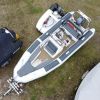Rough water handling in a RIB - part 2
by Paul Glatzel
In the
first article in this series we looked at how to handle a RIB upwind and how to deal with beam seas. We summarised that the key was management of the throttle in conjunction with careful steering to drive a path through the waves. In short it is about reading the waves and adopting a style that suits the specific conditions that you come across.
The conditions you experience can be magnified or reduced by the combination of wind, tide and the local environment. Wind in the opposite direction to the tide ('wind against tide') can create short sharp & unpleasant seas if driving upwind yet markedly different conditions downwind. Short sharp seas can be very difficult to deal with as the helmsman has little time between dealing with each wave to recover and 'plan' how to deal with the next one.
It is not hugely well known but the most dangerous sea for a RIB can be a 'following sea' (the RIB is running in the direction of the wind). If a breaking wave catches the RIB then it will turn it side on to the waves leaving a capsize almost inevitable by the next wave. To avoid this then match the RIB's speed to that of the waves, as the waves can move at up to 23 - 27 knots then this clearly requires a certain power on the part of the RIB to be able to outrun the waves. The way to make progress in these conditions is to ride the wave staying behind the back of the crest and as it breaks power through to sit on the back of the next wave. Care is needed here to not power through the breaking wave too early as the very confused water as the wave breaks can lead the prop to lose grip and thus speed. A good lookout must be kept behind at all times to avoid the chasing waves catching. The other danger to avoid is to go too fast, it is easy to power off the crest of the wave into the abyss of the 'hole' the other side. The result of this tends to be dramatic loss of speed which then leaves the boat exposed to the waves from behind again.
If this following sea is found at the entrance to a harbour then the conditions can get even more lively. Almost by definition as you move towards land then the depth of water is reducing and thus the bottom of the wave is slowing as it drags along the bottom. The wind pushing the wave though is still having its effect and thus the wave tends to grow in height and potentially break. If this occurs where there is a particularly sudden loss of depth (eg at a 'harbour bar' - area of water far shallower than that either side of it) then the change in conditions will be dramatic.
'Crossing a harbour bar' should under no circumstances be attempted without considerable experience and a highly capable vessel. That said there are times when such conditions simply happen upon an unsuspecting vessel entering a harbour after a day out, knowing what to do could make all of the difference. Entering a harbour over a bar with an ebb tide is the worst combination and there needs to a very good reason for not waiting it out or finding another harbour as a refuge. Before making your move over the bar stop and assess the conditions, where are the waves breaking?, do some areas look easier than others? The difference between the approach advocated for the following seas and crossing the bar is the same it is simply the magnitude of the waves and their frequency which makes all of the difference. As the depth of water decreases then so the will slow down and get steeper thus making careful throttle control all the more important. As stated earlier it is imperitive that the following waves don't flip the RIB. Speed and power are essential elements in the safe passage of a RIB, being able to power away from and through trouble is key.
The necessity to cross a bar is clearly a local factor and you will no doubt know of conditions around your area of operation that merit learning about. It could be a tidal race around a headland or particularly viscious conditions near the entrance to a harbour - either way its worth getting to understand how the conditions vary under different tide & wind conditions, then when you experience them you will be better placed to handle them. Whilst there is no substitute for experience there is a strong argument for understanding how to deal with the conditions you might one day face.
That said, it is important that as a RIB helmsman you exercise restraint and care and make sure you don't put your crew, your boat or the rescue services in a dangerous situation, make sure your vessel is capable, and you and your crew build up your experience over time. The RYA Advanced Powerboat Course tackles rough water handling and there are a number of other specialist courses for RIBs that cover crossing bars and extreme conditions.
Paul Glatzel is an Advanced Powerboat Instructor and runs Powerboat Training UK -
www.powerboat-training.co.uk - 01707 322789
© Copyright Paul Glatzel 2001.
This article was first published in Sportsboat and RIB Magazine.















